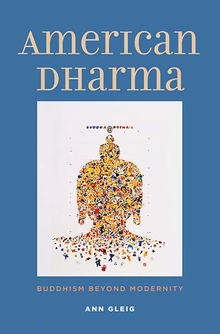Let’s cut to the chase: Ann Gleig, who is an associate professor of religion at the University of Central Florida, has written a splendid book that is an instant classic. American Dharma: Buddhism Beyond Modernity is a ”must read” book for anyone interested in understanding what has been happening in the world of American ”convert” Buddhism over the past decade and where it is headed. The book is comprehensive in fairly covering the myriad trends, countertrends, and controversies that have roiled the convert Buddhist community in recent years—especially in the American Zen, Insight Meditation, mindfulness, Secular Buddhist, and on-line Buddhist communities. Gleig sees these trends as part of the larger narrative of the transition of Western culture from modernism to postmodernism, post-secularism, post-colonialism, and digital literacy. She sees ”boomer generation” Buddhist modernism as subject to a variety of critiques from millennials and Gen Xers, Asian heritage Buddhists, people of color, and queer and transgendered people. She also sees Buddhist modernism as subject to critiques from those who think it has modernized too far and those who think it hasn’t modernized enough. Finally, there are the hot button issues of the sexual scandals in Buddhist communities and the controversies over whether mindfulness is being commodified, taught outside of an ethical context, or being used as a handmaiden to economic interests.
Gleig covers all of these issues with both scholarly thoroughness and a degree of personal acquaintance with many of the institutions and actors she writes about. Her participant-observer stance, writing from both inside and outside of the phenomena she describes, gives the book a genuine vitality. I am also happy to say that she really knows how to write—the book is a pleasure to read all the way through.
That having been said, is there anything that bothered me about the book? Of course there is. Gleig is writing from a specific point of view as a member of Generation X, as a political progressive, and as an LGBTQ feminist. I, on the other hand, am reading her book from the point of view as an aging, Ashkenazi, cisgender, straight, boomer Buddhist modernist who is politically liberal in the older sense of the word rather than progressive in the newer sense. This means that she reads almost all these critiques as positive steps to cheer about, whereas I belong to the generation on their receiving end. While they may be merited, it’s hard for me to be unabashedly happy about them.
I still subscribe to the old-time liberal belief in inclusiveness, rather than the newer identity politics of anti-racism, call out culture, and intersectionality. Some of the progressive critique of liberalism is well-taken if it is seen as calling for a recognition and celebration of differences rather than a color-blind attempt to erase them, or is calling for lighter-skinned people to recognize the pervasive ways in which American culture has systematically disadvantaged and oppressed people of color, or an interrogation of how lighter skin carries advantages whether one wishes it to or not. We all can benefit from questioning the degree to which we are complicit in a culture that harms others, but there are ways in which I give these newer trends only one or two cheers rather than three.
I recently attended a large progressive Buddhist gathering which broke up into smaller groups where I was asked to state ”what would make me feel safe” and what pronoun I would prefer being called by. I recognized the good intentions behind this, but personally experienced it as excessive and alienating. Maybe I was feeling the way minorities have always felt in alien contexts, but I–being a creature of privilege–was unaware of it? Nevertheless, I felt like a bit of a dinosaur in this brave new world.
Perhaps I was.

